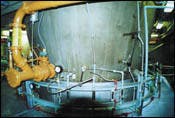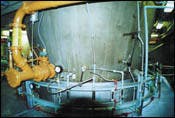The reduction of wastewater sludge volume is one of the most challenging waste management problems facing municipalities, especially since most sludge combustion permits have restrictive conditions. Most system operators seek to maximize operational flexibility while minimizing emissions and costs. A high temperature fluid bed (HTFB) incinerator can reduce sludge volume without the environmental hazards of conventional incineration.
An HTFB incinerator consists of three zones an air receiver wind box, a combustion zone and bed, and a freeboard retention chamber. The term "fluid bed" refers to the turbulent boiling action of sand that occurs when air is blown through a sand bed. While static, a fluid bed consists of an inert sand bed supported on an air distributor dome. As air is forced up through the dome and sand bed, the individual particles of the bed "fluidize." At a certain air velocity, the particles become suspended in the air stream; this vigorous mixture is used as combustion air for the incineration process.
The particle layer behaves like a boiling liquid and the heat transfer coefficient increases as the layer becomes fluidized. This high heat transfer rate, together with the intensive mixing in the fluid bed, results in a uniform incineration process throughout the confines of the bed. The mass of sand heated to incineration temperature provides a large thermal reservoir that protects against rapid temperature fluctuations.
The required incineration temperature is accomplished by a preheat burner. At bed operating temperature, the sludge is continually fed to the fluid bed, where it is dried and disintegrated in the sand layer. In order to reduce or eliminate the need for auxiliary fuel, an air-to-gas heat exchanger recovers the heat from the off gas and preheats the fluidized air to around 1,300° F.
The Little Miami Wastewater Treatment Plant in Cincinnati, OH, is a 90 mgd primary treatment, 55 mgd activated sludge treatment plant. The Metropolitan Sewer District of Greater Cincinnati commissioned ONDEO Degremont (formerly Infilco Degremont) to supply and install a 72 dry ton per day fluid bed reactor to replace a multiple hearth incinerator.
The Metropolitan Sewer District performed an extensive evaluation of combustion technology before proceeding with the design of the fluid bed reactor. An ONDEO HTFB incinerator was selected to replace a multiple hearth incinerator.
The HTFB is energy efficient and easy to operate and maintain. It has no moving parts. Its heat recovery system minimizes auxiliary fuel consumption since the burner is not required during operation. The unit is adaptable to non-continuous operation, so it can be operated to match shift schedules. The control system is simple to operate because it entails only two variables bed temperature and excess air. And, unlike conventional incinerators, the HTFB has the ability to handle other wastewater residuals such as grease.
The Little Miami WWTP staff, in conjunction with a third party professional testing firm, conducted testing over a wide operating range to optimize emissions. Since its first day of operation, the HTFB incinerator has met or exceeded all EPA 503 performance standards.
The incinerator reduced pollutant emissions, especially NOx (nitrogen oxides). Gaseous emissions of carbon monoxide, sulfur dioxide, and total hydrocarbon compounds were found to be minimal. For all metals except mercury, removal exceeded 99.89 percent. Measurement of particulate matter was also very favorable.
Plume suppression was an important consideration at the Little Miami WWTP, as the plant has a 124-foot stack that is visible from many locations in the surrounding community. A secondary heat exchanger heats the exhaust gas to 250° F to eliminate a visible fume. At no time has stack odor from the incineration system been noticed.
Booth 1749




